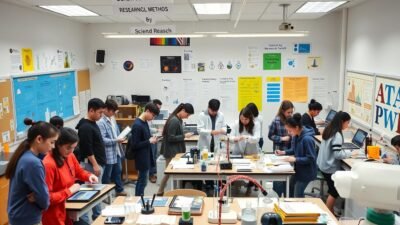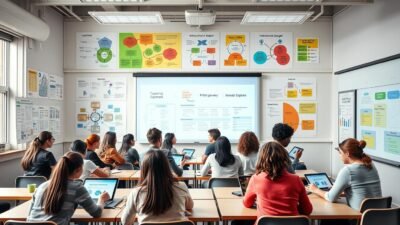Curriculum development shapes the future of education in our changing world. It’s the backbone of learning in schools across India. Let’s explore how educational visions become real, effective learning experiences.
Curriculum development goes beyond creating lesson plans. It’s a full approach to crafting educational roadmaps. This process guides how we share knowledge, build skills, and shape futures.
It balances tradition with innovation. It combines proven educational theories and new learning strategies. In India’s diverse schools, good curriculum development is vital.
It must meet the needs of many different students. It bridges gaps and creates opportunities. We’ll look at the parts of this complex process.
We’ll cover setting clear goals and making flexible learning paths. These paths help every student reach their potential.
Preparing for the UGC NET exam can be a daunting task, but with the right resources, candidates can navigate the process effectively. Websites like MyJRF provide a comprehensive platform for aspiring educators, offering specialized guidance for UGC NET Paper 2 preparation and essential tips for acing UGC NET Paper 1. Additionally, understanding the revised syllabus provided by UGC is crucial for a targeted study approach. For official announcements and updates, candidates should regularly visit the UGC NET NTA portal, while the UGC’s job section and the main UGC website are invaluable for post-exam opportunities and academic resources. With these tools, candidates can maximize their preparation and set themselves up for success.
Key Takeaways
- Curriculum development is crucial for creating effective learning experiences
- It involves a systematic approach applicable across various educational settings
- The process balances traditional methods with innovative learning strategies
- Clear objectives and flexible learning paths are essential components
- Effective curricula address the diverse needs of India’s student population
Understanding the Foundations of Education
Education shapes minds and futures, forming society’s foundation. This section explores core elements driving educational systems. We’ll examine their impact on schools, academic programs, and professional growth.
The Importance of Curriculum
Curriculum is education’s backbone. It outlines what students should learn and how they’ll be taught. A strong curriculum ensures schools deliver quality education across all grades.
Key Educational Theories
Educational theories guide teaching practices in schools. Constructivism emphasizes active learning through experiences. Behaviorism focuses on observable behaviors and reinforcement.
These theories shape how teachers approach lessons and interact with students. They provide a framework for effective teaching methods.
Role of Stakeholders
Education involves many players. Teachers implement curriculum daily. Administrators manage schools and set policies. Parents support learning at home.
Policymakers create educational standards. Each stakeholder contributes to academic success and student achievement. Their roles are crucial for a well-functioning educational system.
| Stakeholder | Primary Role |
|---|---|
| Teachers | Implement curriculum, guide student learning |
| Administrators | Manage school operations, enforce policies |
| Parents | Support learning at home, collaborate with schools |
| Policymakers | Set educational standards, allocate resources |
Grasping these foundations is key for anyone in education. It helps create effective learning environments. It also supports ongoing professional development in the field.
Identifying Learning Objectives
Clear learning objectives are vital in education. They guide the learning process and measure student progress. These objectives are crucial for both academic programs and professional development.
Aligning with Standards
Educational standards provide a framework for learning objectives. They ensure consistency across schools and prepare students for future challenges. Teachers use these standards to create a cohesive learning experience.
The Indian National Education Policy 2020 highlights key areas:
- Holistic development
- Critical thinking skills
- Experiential learning
- Multilingualism
SMART Goals in Education
SMART goals help create effective learning objectives. This approach ensures goals are well-defined and achievable.
| Aspect | Description |
|---|---|
| Specific | Clear and focused on a particular skill or knowledge area |
| Measurable | Can be assessed through tests, projects, or observations |
| Achievable | Realistic for students to accomplish within the given timeframe |
| Relevant | Connected to the curriculum and students’ needs |
| Time-bound | Has a specific deadline for completion |
SMART goals help educators create targeted learning experiences. These goals boost student achievement and improve educational outcomes. They provide a clear path for success in the classroom.
Designing the Curriculum Structure
A strong curriculum structure is vital for effective education. It requires careful planning to create a comprehensive learning experience. Various elements must be considered in this process.
Frameworks and Models
Educators use different frameworks to shape curriculum design. The Understanding by Design model focuses on backward planning, starting with desired outcomes. The 5E Instructional Model emphasizes engagement, exploration, explanation, elaboration, and evaluation.
These frameworks help create coherent and purposeful learning experiences. They guide educators in developing effective curricula for students.
Integrating Technology
Educational technology is crucial in modern curriculum design. Online courses and distance learning platforms offer flexibility and accessibility. Digital tools like interactive simulations enhance student engagement.
Integrating these technologies prepares students for a tech-driven world. It also makes learning more interactive and engaging.
Flexible Learning Paths
Curriculum designers now prioritize flexible learning paths. This approach caters to diverse student needs and allows for personalized learning experiences. Students can progress at their own pace and choose from various resources.
Flexible paths support different learning styles. They also promote student autonomy and self-directed learning.
| Traditional Curriculum | Flexible Curriculum |
|---|---|
| Fixed timeline | Self-paced learning |
| Uniform content | Personalized resources |
| Limited choices | Multiple learning paths |
Combining proven frameworks, technology, and flexible paths creates dynamic curricula. This approach meets the diverse needs of today’s learners. It ensures a more engaging and effective educational experience.
Developing Inclusive Content
Inclusive educational content is vital in today’s diverse learning environments. Schools must cater to various learners, ensuring equal access to quality education. This approach benefits all students, regardless of their backgrounds or abilities.
Recognizing Diverse Learners
Schools need to acknowledge the varied backgrounds and abilities in their classrooms. This recognition helps develop inclusive content that engages all students effectively. It forms the basis for creating a truly inclusive learning environment.
- Cultural diversity
- Learning disabilities
- Language barriers
- Varied socioeconomic backgrounds
Adapting Materials for Accessibility
Schools must adapt their resources to meet all students’ needs. This involves modifying existing materials and creating new, accessible ones. Such adaptations ensure that every student can fully participate in the learning process.
| Adaptation Strategy | Purpose | Example |
|---|---|---|
| Text-to-speech | Support visually impaired students | Screen reader compatibility for digital textbooks |
| Multilingual resources | Assist non-native speakers | Bilingual worksheets and instructions |
| Visual aids | Help visual learners and those with reading difficulties | Infographics and diagrams in lesson materials |
| Flexible formats | Accommodate different learning styles | Offering content in text, audio, and video formats |
These strategies create a more inclusive learning environment. They support all students’ educational journeys, regardless of their background or abilities. Implementing these approaches helps schools foster a truly diverse and inclusive classroom.
Engaging Teaching Strategies
Education has evolved, and so have teaching strategies. Modern educators use innovative approaches to boost student engagement. Let’s explore effective methods transforming education.
Active Learning Techniques
Active learning puts students at the center of education. It encourages participation and hands-on experiences. In online courses, students might engage in virtual simulations or interactive quizzes.
These techniques help learners retain information better. They also allow students to apply concepts in real-world scenarios.
Collaborative Learning Approaches
Collaboration is key in today’s interconnected world. Educational technology allows for virtual group projects and online discussions. Students can work together across distances, sharing ideas and solving problems.
This approach improves learning outcomes. It also develops crucial teamwork skills.
Incorporating Multimedia
Multimedia resources have revolutionized learning. Videos, podcasts, and interactive presentations make complex topics more accessible. In online courses, students can access visual and audio content.
This variety caters to different learning styles. It keeps students engaged throughout their educational journey.
| Strategy | Benefits | Examples |
|---|---|---|
| Active Learning | Improved retention, critical thinking | Virtual labs, case studies |
| Collaborative Learning | Enhanced communication, problem-solving | Group projects, peer reviews |
| Multimedia Integration | Increased engagement, varied learning styles | Educational videos, interactive diagrams |
These strategies create dynamic learning environments. They prepare students for future challenges. Technology in education opens new possibilities for engaging teaching methods.
Assessment and Evaluation Methods
Assessing student progress and evaluating curriculum effectiveness are vital in education. These processes help gauge learning outcomes and improve teaching strategies. Let’s explore key aspects of assessment in educational settings.
Formative vs. Summative Assessment
Formative assessment tracks student learning during the educational process. It provides ongoing feedback to enhance teaching and learning. Summative assessment evaluates learning at the end of an instructional unit.
| Formative Assessment | Summative Assessment |
|---|---|
| Quizzes | Final exams |
| Class discussions | Term papers |
| Peer reviews | Standardized tests |
Tools for Evaluation
Educational technology offers various tools for assessment. These include online quizzes, digital portfolios, and learning management systems. Such tools simplify evaluation and provide detailed insights into student performance.
Feedback Mechanisms
Effective feedback is crucial in the learning process. It helps students understand their strengths and areas for improvement. Teachers can use rubrics, written comments, or one-on-one conferences to provide constructive feedback.
This ongoing communication supports student growth and enhances the overall learning experience. It fosters a positive environment for academic progress in schools and programs.
“Feedback is the breakfast of champions.” – Ken Blanchard
Continuous Improvement of Curriculum
Schools constantly update learning plans to keep education fresh. They strive to offer students the best possible education. This involves evaluating classroom successes and areas for improvement.
Gathering Feedback from Stakeholders
Teachers, students, and parents contribute valuable insights for enhancing learning. Schools collect their opinions through surveys and meetings. This feedback helps identify curriculum strengths and areas needing improvement.
- Student surveys about classes
- Parent-teacher conferences
- Teacher workshops on curriculum
Data-Driven Decision Making
Schools analyze test scores and other data to assess student learning. This information guides decisions on curriculum changes. They examine various factors to inform their choices.
| Data Type | Use in Curriculum Improvement |
|---|---|
| Test Scores | Show which subjects need more focus |
| Attendance Rates | Indicate student engagement levels |
| Graduation Rates | Reflect overall curriculum effectiveness |
Feedback and data help schools make smart curriculum choices. This approach enhances student learning and prepares them for future success. Teacher professional development is crucial for implementing these improvements effectively.
Professional Development and Support
Professional development is vital in education. It keeps educators up-to-date with the latest teaching methods. Continuous learning helps teachers improve their skills and adapt to changes.
Training for Educators
Effective training programs focus on practical skills and innovative teaching strategies. These include workshops, seminars, and online courses. They cover classroom management, technology integration, and subject-specific teaching methods.
Many schools offer in-house training sessions. These allow teachers to collaborate and share best practices. Popular training formats include peer observation, mentoring programs, and professional learning communities.
- Peer observation and feedback
- Mentoring programs for new teachers
- Professional learning communities
- Summer institutes for intensive skill-building
Resources for Ongoing Learning
Educational resources support teachers in their professional growth. Universities often partner with schools to provide research access. They also offer advanced learning opportunities.
Valuable resources include online platforms, professional journals, and conferences. These help educators stay current with educational trends and best practices.
| Resource Type | Examples | Benefits |
|---|---|---|
| Online Platforms | Coursera, edX, Udemy | Flexible learning schedules, diverse course options |
| Professional Journals | Educational Researcher, Teaching and Teacher Education | Access to current research and best practices |
| Conferences | ASCD Annual Conference, ISTE Conference & Expo | Networking opportunities, exposure to new ideas |
| Webinars | TeachersFirst, EdWeb | Convenient, topic-specific learning sessions |
Engaging with these resources helps educators improve their teaching. It keeps them at the forefront of educational innovation. By using these tools, teachers can continually refine their skills.
Finalizing and Implementing the Curriculum
The final stage of curriculum development puts plans into action. This phase ensures educational goals are met across schools and programs. It’s where theory meets practice, shaping education’s future.
Pilot Programs and Testing
Schools often run pilot programs before full implementation. These tests help spot issues in the new curriculum. Teachers and students give feedback for adjustments.
This step is vital for distance learning programs. Technology plays a key role in these programs.
Full-Scale Implementation Strategies
After pilot tests, the curriculum rolls out to all schools. This process needs careful planning. Teachers need training on new methods and materials.
Schools must have the right resources in place. Clear communication helps everyone understand their role.
Monitoring and Adjusting Plans
Education evolves, and so should the curriculum. Regular checks keep academic programs on track. Schools gather data on student performance and teacher experiences.
This info guides future updates to the curriculum. It’s an ongoing process that keeps education relevant.
FAQ
What are the essential stages in curriculum development?
Curriculum development involves several key stages. These include understanding educational foundations and identifying learning objectives. Designing the structure, developing content, and creating teaching strategies are also crucial. Assessment methods, continuous improvement, and professional development complete the process.
How do educational theories influence curriculum development?
Educational theories shape how we design curricula. They provide frameworks for understanding student learning and effective teaching methods. Theories like constructivism guide the creation of learning objectives and assessment methods.
What are SMART goals in education?
SMART goals are Specific, Measurable, Achievable, Relevant, and Time-bound objectives. They help create clear, focused learning outcomes. SMART goals ensure curriculum development aligns with educational standards.
How can technology be integrated into curriculum development?
Technology enhances curriculum through digital tools and online resources. Learning management systems and interactive multimedia can boost student engagement. These tools also facilitate personalized learning and prepare students for the digital world.
What strategies can be used to develop inclusive educational content?
Inclusive content recognizes diverse learning needs and adapts materials for accessibility. Using universal design principles and incorporating multicultural perspectives is key. Providing multiple means of expression and ensuring bias-free content creates curricula for all students.
What is the difference between formative and summative assessment?
Formative assessment monitors progress and provides feedback throughout the learning process. Summative assessment evaluates learning at the end of a unit or course. Formative guides teaching, while summative measures overall achievement.
How can educators gather feedback for curriculum improvement?
Educators can use surveys, peer reviews, and classroom observations for feedback. Analyzing student data and holding stakeholder meetings also help. This data-driven approach ensures curriculum meets all participants’ needs.
What role does professional development play in curriculum implementation?
Professional development equips educators to deliver new curricula effectively. It provides knowledge and skills for new teaching strategies and technology integration. Ongoing training supports continuous improvement based on best practices and research.
How are pilot programs used in curriculum development?
Pilot programs test new educational approaches on a small scale. They help identify challenges and gather feedback before full implementation. These programs provide insights that inform the implementation strategy and increase adoption success.
What is the importance of flexible learning paths in curriculum design?
Flexible learning paths cater to diverse student needs and learning styles. They allow for personalized experiences and varied progression through the curriculum. Options like distance learning and self-paced modules promote greater engagement and success.





